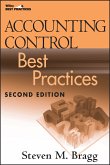CAPEX Excellence (eBook, PDF)
Optimizing Fixed Asset Investments


Alle Infos zum eBook verschenken

CAPEX Excellence (eBook, PDF)
Optimizing Fixed Asset Investments
- Format: PDF
- Merkliste
- Auf die Merkliste
- Bewerten Bewerten
- Teilen
- Produkt teilen
- Produkterinnerung
- Produkterinnerung

Hier können Sie sich einloggen

Bitte loggen Sie sich zunächst in Ihr Kundenkonto ein oder registrieren Sie sich bei bücher.de, um das eBook-Abo tolino select nutzen zu können.
Much of current management literature focuses on a limited set of 'classical' value levers, such as cost reduction, sales optimization or mergers & acquisitions, thus neglecting another core value lever: capital investments. That capital investments receive such limited attention is all the more surprising when one considers how vitally important they are to the economy as a whole as well as individual businesses. There is significant value-creation potential in optimizing capital investments. Investments not only determine the asset structure of a venture. They also enable the introduction of…mehr
- Geräte: PC
- mit Kopierschutz
- eBook Hilfe
- Größe: 6.42MB
![Cost Reduction Analysis (eBook, PDF) Cost Reduction Analysis (eBook, PDF)]() Steven M. BraggCost Reduction Analysis (eBook, PDF)50,99 €
Steven M. BraggCost Reduction Analysis (eBook, PDF)50,99 €![Quantitative Methods for ESG Finance (eBook, PDF) Quantitative Methods for ESG Finance (eBook, PDF)]() Cyril ShmatovQuantitative Methods for ESG Finance (eBook, PDF)32,99 €
Cyril ShmatovQuantitative Methods for ESG Finance (eBook, PDF)32,99 €![Corporate Turnaround Artistry (eBook, PDF) Corporate Turnaround Artistry (eBook, PDF)]() Jeff SandsCorporate Turnaround Artistry (eBook, PDF)27,99 €
Jeff SandsCorporate Turnaround Artistry (eBook, PDF)27,99 €![Private Capital Markets (eBook, PDF) Private Capital Markets (eBook, PDF)]() Robert T. SleePrivate Capital Markets (eBook, PDF)80,99 €
Robert T. SleePrivate Capital Markets (eBook, PDF)80,99 €![Reporting Nonfinancials (eBook, PDF) Reporting Nonfinancials (eBook, PDF)]() Kaevan GazdarReporting Nonfinancials (eBook, PDF)61,99 €
Kaevan GazdarReporting Nonfinancials (eBook, PDF)61,99 €![The Sarbanes-Oxley Section 404 Implementation Toolkit (eBook, PDF) The Sarbanes-Oxley Section 404 Implementation Toolkit (eBook, PDF)]() Michael J. RamosThe Sarbanes-Oxley Section 404 Implementation Toolkit (eBook, PDF)84,99 €
Michael J. RamosThe Sarbanes-Oxley Section 404 Implementation Toolkit (eBook, PDF)84,99 €![Accounting Control Best Practices (eBook, PDF) Accounting Control Best Practices (eBook, PDF)]() Steven M. BraggAccounting Control Best Practices (eBook, PDF)73,99 €
Steven M. BraggAccounting Control Best Practices (eBook, PDF)73,99 €-
-
-
Dieser Download kann aus rechtlichen Gründen nur mit Rechnungsadresse in A, B, BG, CY, CZ, D, DK, EW, E, FIN, F, GR, HR, H, IRL, I, LT, L, LR, M, NL, PL, P, R, S, SLO, SK ausgeliefert werden.
- Produktdetails
- Verlag: John Wiley & Sons
- Seitenzahl: 232
- Erscheinungstermin: 28. August 2009
- Englisch
- ISBN-13: 9780470748763
- Artikelnr.: 37299271
- Verlag: John Wiley & Sons
- Seitenzahl: 232
- Erscheinungstermin: 28. August 2009
- Englisch
- ISBN-13: 9780470748763
- Artikelnr.: 37299271
- Herstellerkennzeichnung Die Herstellerinformationen sind derzeit nicht verfügbar.
About the Authors.
PART I WHY INVESTMENTS MATTER.
1 Introduction.
1.1 Investments: the forgotten value lever.
1.1.1 The early bird catches the worm.
1.2 A bird's-eye view of the book content.
1.2.1 Part I: Why investments matter.
1.2.2 Part II: Getting investments right.
1.2.3 Part III: Right allocation: Managing a company's investment
portfolio.
1.3 Why investments matter: the importance and structure of capital
investments.
1.3.1 The relevance of capital investments.
1.3.2 The structure of capital investments.
1.3.3 Time dependence of capital investments.
1.3.4 The future of capital investments.
1.4 Summary.
Appendix 1.1: Wavelet analysis: Extracting frequency information from
investment timelines.
References.
PART II GETTING INVESTMENTS RIGHT.
2 Right Positioning: Managing an Asset's Exposure to Economic Risk.
2.1 Preface.
2.2 Asset exposure determines the achievable return on an investment.
2.3 Five levels of protection determine the asset exposure.
2.4 A simple scoring metric to measure asset exposure.
2.5 Quantitative asset exposure analysis shows high correlation with ROIC
at all levels.
2.5.1 Using exposure level analysis for benchmarking.
2.6 Strategies to reduce asset exposure.
2.6.1 Strategy 1: Create public-private, win-win situations in natural
monopoly environments.
2.6.2 Strategy 2: Foster regulatory conditions that enable sufficient
investment levels.
2.6.3 Strategy 3: Create the right structural conditions and ensure fair
access to scarce resources.
2.6.4 Strategy 4: Establish protection for intellectual property.
2.6.5 Strategy 5: Achieve a strong commercial position.
2.6.6 Strategy 6: Minimize fixed capital costs or outsource asset ownership
(go "asset light").
2.7 Summary.
3 Right Technology: How to Optimize Innovation Timing and Risks.
3.1 Capital investments in technology innovation.
3.1.1 Technology analysis.
3.1.2 Assess risks.
3.1.3 Mitigating technology risks.
3.2 Summary.
4 Right Timing: How Cyclicality Affects Return on Investments and What
Companies Can Do About It.
4.1 How cyclicality destroys value.
4.2 Industry drivers of cyclicality.
4.2.1 Impact of investment lead times.
4.2.2 Slow-to-no market growth.
4.2.3 High price sensitivity.
4.2.4 Investment timing with respect to the cycle.
4.3 Developing an economic model of cyclicality.
4.3.1 A fundamental law of economic cycles.
4.3.2 Base parameters of simple economic oscillations.
4.3.3 Reaction of cyclical systems to external "excitation".
4.3.4 Economic cycles with more than one player present.
4.4 Measures to cope with cyclicality.
4.4.1 Reaction delay.
4.4.2 Reaction strength.
4.4.3 "Jokers" that can help beat the cycle.
4.4.4 Where no joker is available.
4.5 Summary.
Appendix 4A: A differential equation for economic cyclicality.
Reference.
5 Right Size: Balancing Economies and Diseconomies of Scale.
5.1 Introduction: The role of scale in determining profitability.
5.2 Assessing economies of scale.
5.2.1 Fixed cost leverage.
5.2.2 Decreasing unit costs.
5.2.3 Equipment utilization/chunkiness of capacity.
5.2.4 Critical size.
5.3 Determining diseconomies of scale.
5.3.1 Cost elements.
5.4 Risk elements.
5.4.1 Utilization risks.
5.4.2 Market reaction risks.
5.4.3 Technology risks.
5.4.4 Timing risks.
5.5 An approach for finding the "sweet spot".
5.5.1 Scale effect model.
5.6 Real-life examples.
5.6.1 Automotive industry case example.
5.6.2 Base chemicals case example.
5.7 Summary.
Reference.
6 Right Location: Getting the Most from Government Incentives.
6.1 Government incentives: An overview.
6.1.1 Creating public-private, win-win situations.
6.2 Common types of incentive instruments.
6.2.1 Subsidies.
6.2.2 Financing support.
6.2.3 Tax relief.
6.2.4 Other types of government incentives.
6.3 The financial impact of incentives: A modeling approach.
6.3.1 General impact of subsidies.
6.3.2 General impact of financing support.
6.3.3 General impact of tax relief.
6.3.4 Specific impact of incentives on different industries.
6.4 Geographical differences in incentive structures.
6.5 Managing government incentives.
6.6 Summary.
References.
7 Right Design: How to Make Investments Lean and Flexible.
7.1 Lean design as a competitive advantage.
7.1.1 The lean way: Moving from capital investment projects to a lean
design system.
7.2 The three dimensions of a lean capital investment system.
7.3 Dimension 1: The technical system.
7.3.1 Start with project objectives, design princisples, and target
setting.
7.3.2 Value engineering and lean tools.
7.3.3 Design optimization.
7.3.4 From the basic design to start of production.
7.3.5 Anchoring tools and practices to formal standards.
7.4 Dimensions 2 & 3: Management infrastructure, mindset and behavior.
7.4.1 Project organization and performance management.
7.4.2 Institutionalization and learning.
7.4.3 Adapting the system to local specifics: Project design cannot be "one
size fits all".
7.4.4 Getting started.
7.5 Flexibility: Just what customers and the company need and no more.
7.5.1 Macro-level flexibility: modularity in plant design to ensure
flexible, cost-efficient assets.
7.5.2 Midi-level flexibility in plant design: cater for product portfolio
diversity.
7.5.3 Micro-level flexibility in plant design: design for iso-productivity.
7.6 How to avoid creating a front-page disaster: Anticipating what can go
wrong.
7.6.1 Performance management and decision making.
7.6.2 Tools which every company and project team need to master.
7.6.3 Cross-functional coordination.
7.7 Summary.
References.
8 Right Financing: Shaping the Optimal Finance Portfolio.
8.1 Why Financing Matters.
8.2 Three-Step Financing Approach.
8.2.1 Step 1: Evaluating the investment's cash flow parameters.
8.2.2 Step 2: Assessing investment risks.
8.2.3 Step 3: Composing the financing portfolio.
8.3 Summary.
References.
PART III.
9 Right Allocation: How to Allocate Money Within the Company.
9.1 Key requirements for capital allocation.
9.2 Four models of the corporate center role in shaping the investment
portfolio.
9.3 Capital allocation approach for operators and strategic controllers.
9.3.1 Step 1: Treat special projects as high priority.
9.3.2 Step 2: Allocate remaining capital to business units.
9.3.3 Step 3: Business units distribute capital to individual investments.
9.3.4 Step 4: Implement a capital assurance process.
9.3.5 Improving the "capital allocation key".
9.3.6 Capital allocation backbone.
9.4 Capital allocation approach for strategic architects and financial
holding structures.
9.5 Summary.
References.
Index.
About the Authors.
PART I WHY INVESTMENTS MATTER.
1 Introduction.
1.1 Investments: the forgotten value lever.
1.1.1 The early bird catches the worm.
1.2 A bird's-eye view of the book content.
1.2.1 Part I: Why investments matter.
1.2.2 Part II: Getting investments right.
1.2.3 Part III: Right allocation: Managing a company's investment
portfolio.
1.3 Why investments matter: the importance and structure of capital
investments.
1.3.1 The relevance of capital investments.
1.3.2 The structure of capital investments.
1.3.3 Time dependence of capital investments.
1.3.4 The future of capital investments.
1.4 Summary.
Appendix 1.1: Wavelet analysis: Extracting frequency information from
investment timelines.
References.
PART II GETTING INVESTMENTS RIGHT.
2 Right Positioning: Managing an Asset's Exposure to Economic Risk.
2.1 Preface.
2.2 Asset exposure determines the achievable return on an investment.
2.3 Five levels of protection determine the asset exposure.
2.4 A simple scoring metric to measure asset exposure.
2.5 Quantitative asset exposure analysis shows high correlation with ROIC
at all levels.
2.5.1 Using exposure level analysis for benchmarking.
2.6 Strategies to reduce asset exposure.
2.6.1 Strategy 1: Create public-private, win-win situations in natural
monopoly environments.
2.6.2 Strategy 2: Foster regulatory conditions that enable sufficient
investment levels.
2.6.3 Strategy 3: Create the right structural conditions and ensure fair
access to scarce resources.
2.6.4 Strategy 4: Establish protection for intellectual property.
2.6.5 Strategy 5: Achieve a strong commercial position.
2.6.6 Strategy 6: Minimize fixed capital costs or outsource asset ownership
(go "asset light").
2.7 Summary.
3 Right Technology: How to Optimize Innovation Timing and Risks.
3.1 Capital investments in technology innovation.
3.1.1 Technology analysis.
3.1.2 Assess risks.
3.1.3 Mitigating technology risks.
3.2 Summary.
4 Right Timing: How Cyclicality Affects Return on Investments and What
Companies Can Do About It.
4.1 How cyclicality destroys value.
4.2 Industry drivers of cyclicality.
4.2.1 Impact of investment lead times.
4.2.2 Slow-to-no market growth.
4.2.3 High price sensitivity.
4.2.4 Investment timing with respect to the cycle.
4.3 Developing an economic model of cyclicality.
4.3.1 A fundamental law of economic cycles.
4.3.2 Base parameters of simple economic oscillations.
4.3.3 Reaction of cyclical systems to external "excitation".
4.3.4 Economic cycles with more than one player present.
4.4 Measures to cope with cyclicality.
4.4.1 Reaction delay.
4.4.2 Reaction strength.
4.4.3 "Jokers" that can help beat the cycle.
4.4.4 Where no joker is available.
4.5 Summary.
Appendix 4A: A differential equation for economic cyclicality.
Reference.
5 Right Size: Balancing Economies and Diseconomies of Scale.
5.1 Introduction: The role of scale in determining profitability.
5.2 Assessing economies of scale.
5.2.1 Fixed cost leverage.
5.2.2 Decreasing unit costs.
5.2.3 Equipment utilization/chunkiness of capacity.
5.2.4 Critical size.
5.3 Determining diseconomies of scale.
5.3.1 Cost elements.
5.4 Risk elements.
5.4.1 Utilization risks.
5.4.2 Market reaction risks.
5.4.3 Technology risks.
5.4.4 Timing risks.
5.5 An approach for finding the "sweet spot".
5.5.1 Scale effect model.
5.6 Real-life examples.
5.6.1 Automotive industry case example.
5.6.2 Base chemicals case example.
5.7 Summary.
Reference.
6 Right Location: Getting the Most from Government Incentives.
6.1 Government incentives: An overview.
6.1.1 Creating public-private, win-win situations.
6.2 Common types of incentive instruments.
6.2.1 Subsidies.
6.2.2 Financing support.
6.2.3 Tax relief.
6.2.4 Other types of government incentives.
6.3 The financial impact of incentives: A modeling approach.
6.3.1 General impact of subsidies.
6.3.2 General impact of financing support.
6.3.3 General impact of tax relief.
6.3.4 Specific impact of incentives on different industries.
6.4 Geographical differences in incentive structures.
6.5 Managing government incentives.
6.6 Summary.
References.
7 Right Design: How to Make Investments Lean and Flexible.
7.1 Lean design as a competitive advantage.
7.1.1 The lean way: Moving from capital investment projects to a lean
design system.
7.2 The three dimensions of a lean capital investment system.
7.3 Dimension 1: The technical system.
7.3.1 Start with project objectives, design princisples, and target
setting.
7.3.2 Value engineering and lean tools.
7.3.3 Design optimization.
7.3.4 From the basic design to start of production.
7.3.5 Anchoring tools and practices to formal standards.
7.4 Dimensions 2 & 3: Management infrastructure, mindset and behavior.
7.4.1 Project organization and performance management.
7.4.2 Institutionalization and learning.
7.4.3 Adapting the system to local specifics: Project design cannot be "one
size fits all".
7.4.4 Getting started.
7.5 Flexibility: Just what customers and the company need and no more.
7.5.1 Macro-level flexibility: modularity in plant design to ensure
flexible, cost-efficient assets.
7.5.2 Midi-level flexibility in plant design: cater for product portfolio
diversity.
7.5.3 Micro-level flexibility in plant design: design for iso-productivity.
7.6 How to avoid creating a front-page disaster: Anticipating what can go
wrong.
7.6.1 Performance management and decision making.
7.6.2 Tools which every company and project team need to master.
7.6.3 Cross-functional coordination.
7.7 Summary.
References.
8 Right Financing: Shaping the Optimal Finance Portfolio.
8.1 Why Financing Matters.
8.2 Three-Step Financing Approach.
8.2.1 Step 1: Evaluating the investment's cash flow parameters.
8.2.2 Step 2: Assessing investment risks.
8.2.3 Step 3: Composing the financing portfolio.
8.3 Summary.
References.
PART III.
9 Right Allocation: How to Allocate Money Within the Company.
9.1 Key requirements for capital allocation.
9.2 Four models of the corporate center role in shaping the investment
portfolio.
9.3 Capital allocation approach for operators and strategic controllers.
9.3.1 Step 1: Treat special projects as high priority.
9.3.2 Step 2: Allocate remaining capital to business units.
9.3.3 Step 3: Business units distribute capital to individual investments.
9.3.4 Step 4: Implement a capital assurance process.
9.3.5 Improving the "capital allocation key".
9.3.6 Capital allocation backbone.
9.4 Capital allocation approach for strategic architects and financial
holding structures.
9.5 Summary.
References.
Index.







